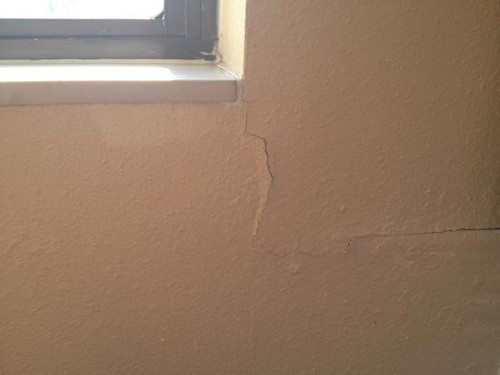Conducting wall plastered is the initial stage of finishing the indoor space. In the future, the quality of the work done will depend on the overall picture of the conceived interior, the feeling of comfort and comfort. But sometimes it happens that, if the rules and recommendations for the performance of work or due to the inexperience of the wizard on the surface, cracks appear on the plaster. But do not fall into a panic, because there is a certain number of techniques that will certainly help to correct the situation. To familiarize yourself with them - read this article.
Content
Why do cracks appear?
Each homeowner who has cracked plaster, wants to find out the reason for this phenomenon. 
The primary reasons for the appearance of cracks are allocated:
- Failure to comply with the technological process of applying a plaster mix.
- Incorrectly sustained proportions of the component of the solution, with a mixing of which there was an excessive amount of binder.
Important! Often, such a phenomenon occurs due to the acquisition of low-quality mixtures of little-known manufacturers.
- Applying a plastering layer with a thickness of over 20 mm, which was not strengthened by special reinforcement racks.
- Insufficiently mixed mortar, as a result, in some places the binding of the binder or the filler appeared.
- Cracking plaster in the process of shrinkage construction and deformation of individual sections.
Important! In addition to these factors, contribute to the destruction of the coating at which the repair of plaster - cracks is required, can simple wear of the material. With a very long period of operation, the technical characteristics and resistance to adverse effects of different phenomena are naturally reduced.
How to warn cracking?
There is a certain number of rules, while observing which the quality of the layer of applied plaster will be better, namely:
- Before applying the plastering solution, moisten the basis with a garden pulverizer or brush.
- The permissible temperature of the room in which finishing works are carried out should not be more than + 24 ° C.
- The contact of direct sunlight and drafts into the room in which construction work is carried out is unacceptable.
- If the layer of plastering, applied to the wall, has a thickness of more than 2 cm, as a strengthening frame, you must certainly use lighthouses.

- When applying each subsequent layer of plaster, make sure that the previous layer must have been captured.
- The thickness of the layer of plaster mixture should not exceed 1.5 cm, and from cement - no more than 2 cm.
- In the process of applying a plaster layer on a brick, stone or concrete base, make sure that the thickness is not over 0.5 cm, and the basis of the tree is 0.9 cm.
- It is very important to adhere to all the recommendations specified by the manufacturer on the packaging with the mixture.
- To obtain the correct consistency of the plaster mortar, follow the order of mixing components.

Important! If all the conditions are observed, then in the future, it is hardly necessary to seal cracks in the plaster. View the video instruction of the correct walls of the walls to make sure you have completed correctly.
What will need tools for sealing formed cracks?
To properly perform repair work, prepare the following tools:
- brush;
- brush;
- staple;
- gypsum-based solution;
- dense sandpaper.
Important! Buy the necessary type of dry mix - identical used when creating the entire coating.
How to make a crack in the plaster?
If there are still cracks on the plaster, do not slow down with its sealing. Otherwise, ignoring timely recovery, it is quite possible, you will have to completely replace it in a short time. 
With a clear observance of all rules and recommendations, climbing cracks will not be much labor. To dismantle the defects formed, follow these steps:
- Spend a crack assessment and clean the deformed place.
Important! Apply a layer of a new solution exclusively for a solid foundation, otherwise it will not hold the desired way and soon new cracks are formed. Also in disabilities to lay a new plaster on a layer of dirt and dust. - Gorge slightly and expand the thin crack to 3-5 mm.
Important! This action is performed using a spatula, knife or any other acute tool.
- Pre-acquire a special firming solution and make the resulting recess.
Important! Such solutions are sold in all building stores. The principle of their actions is as follows - after the penetration of the strengthening solution inland the structure of the plaster, it carefully fastens all the particles among themselves. After the manipulation, you do not have to worry about the fact that the layer of the new solution will be weakly kept. - If the crack dimensions are sufficiently impressive, on top of the neoplasia, make a reinforced painting mesh or gauze.
Important! Check the edges of the mesh performed outside the crack - this is the key to reliable strengthening.
- As a solution for sealing cracks, use a conventional sandy cement mixture or special compositions intended for such purposes.
- Fill out the deepening solution and wait for a complete drying.
- Treat the sealed surface with rough emery paper or other abrasive material.

Conclusion
To properly embed cracks in the plaster, certainly stick to all the above-described conditions of technology. It is the correct compliance with the recommendations provided that will serve as a key to the qualitative performance of repair work. Do not use low-quality mixtures of little-known manufacturers - this will significantly reduce the likelihood of cracks and other deformations.



















